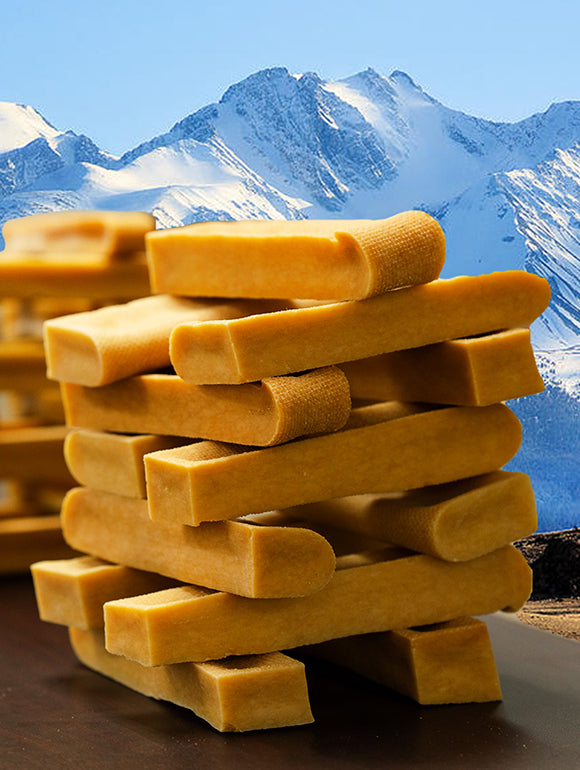
Nov 10, 2025
|Yak&Paws Media
Himalayan Dog Chew Nutrition: What Nutrients Are in Yak Cheese Treats?
Share
Himalayan yak cheese chews—also known as Chhurpi—aren’t just long-lasting and natural. They’re also packed with beneficial nutrients that make them a smart treat choice for your pup. But what exactly is inside these dense, dried blocks of cheese? Let’s break down the nutrition behind these Himalayan dog chews, why they’re easy on the stomach, and how they compare to other popular treats.
Protein Powerhouse

The biggest nutritional standout in Himalayan yak cheese chews is protein. These chews contain over 60% crude protein, making them one of the highest-protein natural dog treats available. That protein comes from casein—the main protein in milk—and helps support your dog’s muscle strength, tissue repair, and overall energy.
Protein content can vary slightly depending on the type of milk used (yak, cow, or Chauri), but studies have consistently shown these chews to range from 60% to 69% protein by weight, according to a 2023 study in Journal of Ethnic Foods.
Low in Fat and Calories
Despite being made from milk, these chews are remarkably lean. Crude fat content is typically low, thanks to the skimming process used during production, as reported in the Journal of Ethnic Foods. That means your dog gets a high-protein snack that’s low in fat and calories—ideal for pups on a weight management plan or with dietary sensitivities.
Naturally Rich in Minerals

Himalayan cheese chews are also a great source of calcium, phosphorus, zinc, and iron—all important for strong bones, healthy teeth, and immune function, according to a 2024 study in the Discover Food. This study shows that 100g of Chhurpi can deliver all dietary protein requirements and over 70% daily calcium, iron and zinc needs of a child. For dogs, it’s an easy way to supplement their mineral intake while chewing.
Almost No Lactose
Worried about dairy? Don’t be. These chews are virtually lactose-free. That’s because the milk sugars are broken down during fermentation, leaving behind a hardened cheese that’s gentle on sensitive stomachs, as indicated in Journal of Ethnic Foods. This makes hard cheese chews suitable for most dogs.
Easy to Digest

Unlike rawhide, which can linger undigested in the gut, yak cheese chews soften as your dog chews, and their small shavings are easy to break down. The chews have very high digestibility—likely in the range of 70-90%, meaning your dog can actually absorb almost all of the the nutrients in these treats. If pets ingest small softening fragments, these cheese chews are fully digestible.
Veterinarians and canine nutrition experts often recommend yak cheese chews as a digestible alternative to rawhide. While the American Kennel Club and Dog Food Advisor caution against rawhide due to its poor digestibility and choking hazard, yak cheese chews soften as dogs chew and are easier to break down, reducing those risks.
Moisture and Shelf Stability
These chews are smoke- or air-dried to remove moisture, which makes them incredibly hard and shelf-stable. Most contain about 10% moisture, helping prevent spoilage and contributing to their long chew time.
Nutrient Snapshot (Yak & Paws Chews)
-
Crude Protein (min): 65%
-
Crude Fat (min): 1%
-
Crude Fiber (max): 3%
-
Moisture (max): 14%
-
Ash (max): 5%
This breakdown reflects the guaranteed analysis of Yak and Paws Himalayan Cheese Chews. See illustration below for a visual breakdown of these nutrients.
What Makes These Nutrients Matter?
-
Protein fuels lean muscle mass, supports tissue healing, and provides lasting energy.
-
Low fat helps manage your dog’s weight and reduces the risk of pancreatitis.
-
Calcium and phosphorus strengthen teeth and bones.
-
Zinc and magnesium support metabolism, immune health, and cell repair.
-
Low lactose and no additives mean fewer tummy troubles.
Compared to Other Chews
| Chew Type | Protein | Digestibility | Fat | Safety |
|---|---|---|---|---|
| Yak Cheese | High | Excellent | Low | Softens while chewing |
| Rawhide | Low | Poor | Varies | Can cause blockages |
| Bully Stick | Moderate | Moderate | High | Fully digestible, but fatty |
| Pig Ear | Low | Moderate | Very High | Often greasy |

Himalayan chews offer a rare combo of high protein, low fat, and easy digestion—without the digestive risks of rawhide or the high fat content of bully sticks.
A Treat That’s Healthy, Too
With just milk and lime, these chews deliver serious nutrition in a minimal-ingredient package. And because they’re so hard and long-lasting, your dog gets more time to enjoy the benefits—while helping clean their teeth, too.
Looking for a healthy chew that doesn’t cut corners? Himalayan dog chews check every box.
References
- Panta, R. et al. (2023). Exploring trade prospects of Chhurpi and the present status of Chhurpi producers and exporters of Nepal. Journal of Ethnic Foods, 10(1), 1. https://doi.org/10.1186/s42779-022-00165-0
- Choudhary, S., et al. (2024). Nutritional quality and microbial diversity of Chhurpe from different milk sources: An ethnic fermented food of high-altitude regions of the Western Himalayas. Discover Food, 4(1), 10. https://doi.org/10.1007/s44187-024-00073-z
- American Kennel Club. (2024). Are Rawhide Chews Dangerous for Dogs? https://www.akc.org/expert-advice/health/are-rawhide-chews-dangerous-for-dog/
- Dog Food Advisor. (2024). Is Rawhide Bad for Dogs? https://www.dogfoodadvisor.com/dog-feeding-tips/rawhide-bad-for-dogs/
